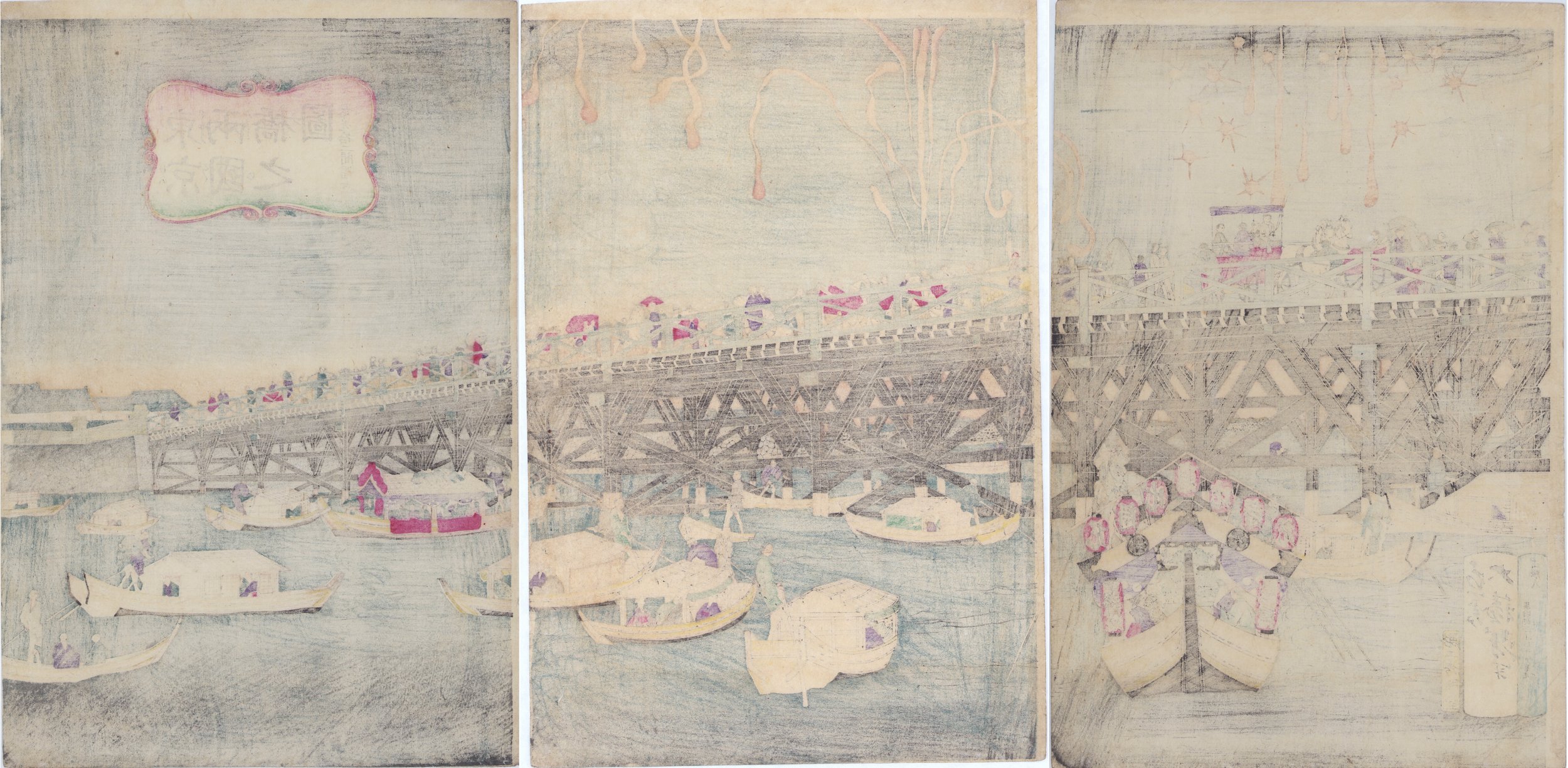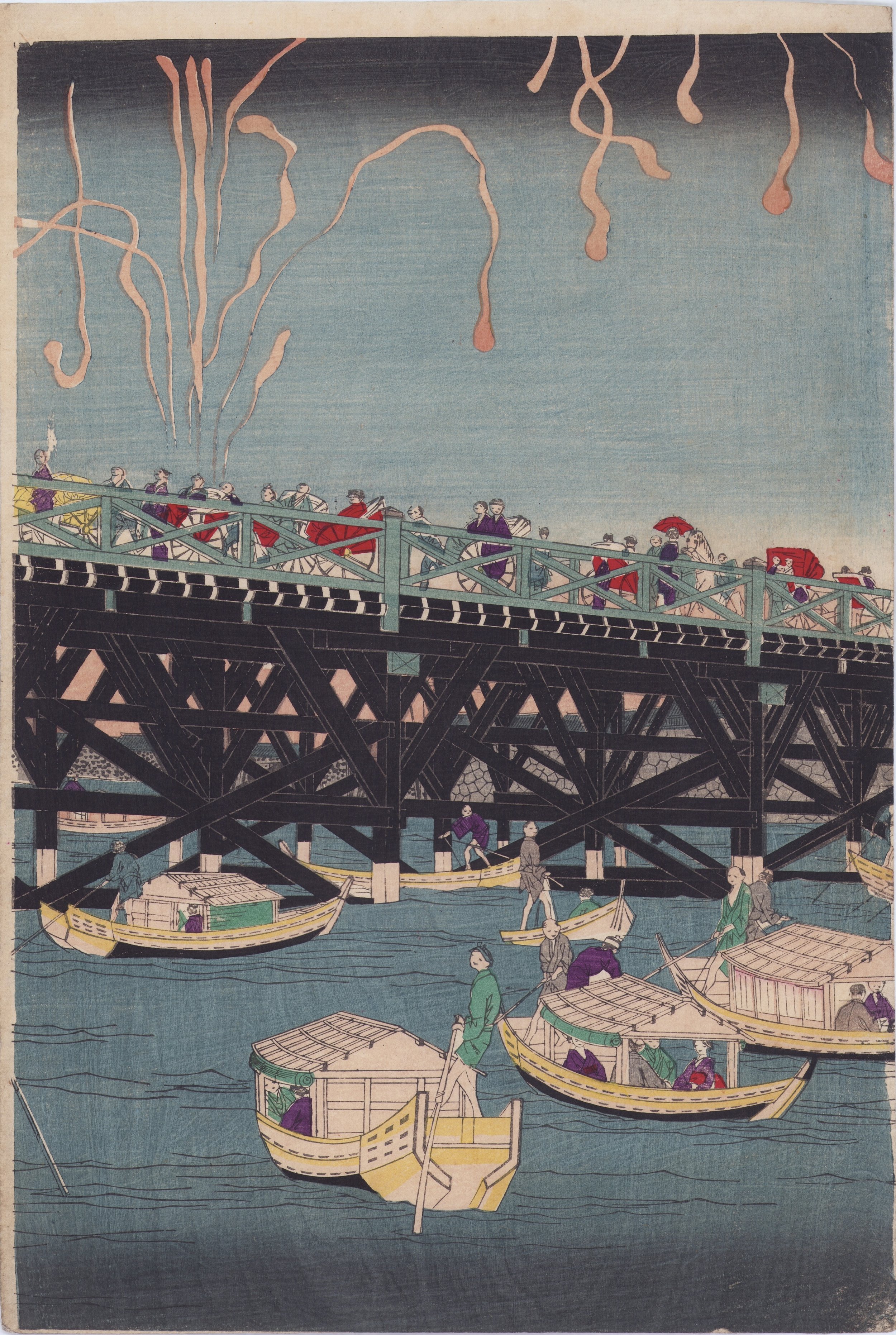Yoshitoshi | View of Ryogoku Bridge in Tokyo
月岡芳年 Tsukioka Yoshitoshi(1839–1892)
东京两国桥之图
View of Ryogoku Bridge in Tokyo
1875
木版画|三幅续绘-纵绘大判|36.8cm × 24.8cm × 3
Woodblock|Triptych-Oban-tate-e|36.8cm × 24.8cm × 3
品相非常好;早期版次
Great condition; early impression
$6,500
Tsukioka Yoshitoshi, a late Ukiyoe master, expanded the form, embracing the high-caliber printing that marked the genre’s final days to create all kinds of new effects, like water reflections and depictions of the moon so nuanced you can almost feel its glow. He would eventually gain fame for warrior and historical prints, often with healthy helpings of blood and gore.
But before he bent the rules, he played by them, and this wonderful three-sheet design from early in his career is a classic example.
Just as Dutch masters of the 1600s loved to paint sailing ships with tall masts because everything else in Holland was so flat, so too did Japanese artists embrace the inherent verticality of bridges. Hokusai, Hiroshige and Hiroshige II all made the famous spans of Edo times the focus of undisputed masterpieces. And there is no denying that the curved, wooden bridges of that era were beautiful examples of the form-follows-function design ethos.
There were also urban centers and meeting places, like town squares, and attractions in and of themselves, even if you didn’t need to get to the other side of the river.
And one of the most famous was Ryogoku Bridge, which was built in 1659 and was one of the nation’s longest. It spanned the Sumida River near where it met the Kanda River. It still does so today, although naturally it is not the same structure.
It was from this bridge – which you may have seen featured in the 2015 anime movie “Miss Hokusai” – that throngs of revelers came to gaze at fireworks, which lit up the skies regularly during summer. Other revelers came on festively lanterned akatabune pleasure boats, drinking sake and enjoying music, the oarsmen weaving skillfully among the bridge’s pilings. These interlocking supports gave artists like Yoshitoshi all kinds of wonderful ways to demonstrate their rendering skills.
The bridge is packed end-to-end. Look at the crowd. This is 1875: Edo has just become Tokyo and the changes sweeping Japan are evident. We see horses and carriages, rickshaws, men in bowler hats, and umbrellas both traditional and Western. The bridge seems to be alive with anticipation of a new era.
This is an early edition with gorgeous printing, sharp lines, and smooth bokashi. The synthetic reds and purples which have recently arrived in Japan are used sparingly, to elegant effect.
A wonderful summer night in Tokyo.
始建于1659年的隅田川两国桥,自江户时代起就是百姓心目中首屈一指的纳凉名所。在这座因东西横跨武藏国与下总国两国而得名的大桥上,曾经举办过无数届花火大会,那些缤纷焰色与夏夜晚风交织的浪漫,为数百年间的一众浮世绘画家提供了完美的创作主题。
数百年间,两国桥曾因被冲毁、焚烧或损坏而多次重建。在本作中,它还是以一座充满着日本传统风情的木桥示人。远方的晚霞还未消散,早早点燃的烟花就已经将天空装点得无比绚烂。桥面上,一辆辆人力车与马车中穿行而过,与打着洋伞摩肩接踵的游人们交织成长龙。桥下,飘飘悠悠的条条屋形船早已在经验丰富的船夫们的操作下占据好观赏位,其间的一二知己、三五好友小酌清酒,谈天说地,好不快活。彼时的江户城虽才改制为东京府短短七年,明治早期的社会变革却已显而易见。两国桥上的烟火,正见证着新时代的到来。
Interested in purchasing?
Please contact us.
月岡芳年 Tsukioka Yoshitoshi(1839–1892)
东京两国桥之图
View of Ryogoku Bridge in Tokyo
1875
木版画|三幅续绘-纵绘大判|36.8cm × 24.8cm × 3
Woodblock|Triptych-Oban-tate-e|36.8cm × 24.8cm × 3
品相非常好;早期版次
Great condition; early impression
$6,500
Tsukioka Yoshitoshi, a late Ukiyoe master, expanded the form, embracing the high-caliber printing that marked the genre’s final days to create all kinds of new effects, like water reflections and depictions of the moon so nuanced you can almost feel its glow. He would eventually gain fame for warrior and historical prints, often with healthy helpings of blood and gore.
But before he bent the rules, he played by them, and this wonderful three-sheet design from early in his career is a classic example.
Just as Dutch masters of the 1600s loved to paint sailing ships with tall masts because everything else in Holland was so flat, so too did Japanese artists embrace the inherent verticality of bridges. Hokusai, Hiroshige and Hiroshige II all made the famous spans of Edo times the focus of undisputed masterpieces. And there is no denying that the curved, wooden bridges of that era were beautiful examples of the form-follows-function design ethos.
There were also urban centers and meeting places, like town squares, and attractions in and of themselves, even if you didn’t need to get to the other side of the river.
And one of the most famous was Ryogoku Bridge, which was built in 1659 and was one of the nation’s longest. It spanned the Sumida River near where it met the Kanda River. It still does so today, although naturally it is not the same structure.
It was from this bridge – which you may have seen featured in the 2015 anime movie “Miss Hokusai” – that throngs of revelers came to gaze at fireworks, which lit up the skies regularly during summer. Other revelers came on festively lanterned akatabune pleasure boats, drinking sake and enjoying music, the oarsmen weaving skillfully among the bridge’s pilings. These interlocking supports gave artists like Yoshitoshi all kinds of wonderful ways to demonstrate their rendering skills.
The bridge is packed end-to-end. Look at the crowd. This is 1875: Edo has just become Tokyo and the changes sweeping Japan are evident. We see horses and carriages, rickshaws, men in bowler hats, and umbrellas both traditional and Western. The bridge seems to be alive with anticipation of a new era.
This is an early edition with gorgeous printing, sharp lines, and smooth bokashi. The synthetic reds and purples which have recently arrived in Japan are used sparingly, to elegant effect.
A wonderful summer night in Tokyo.
始建于1659年的隅田川两国桥,自江户时代起就是百姓心目中首屈一指的纳凉名所。在这座因东西横跨武藏国与下总国两国而得名的大桥上,曾经举办过无数届花火大会,那些缤纷焰色与夏夜晚风交织的浪漫,为数百年间的一众浮世绘画家提供了完美的创作主题。
数百年间,两国桥曾因被冲毁、焚烧或损坏而多次重建。在本作中,它还是以一座充满着日本传统风情的木桥示人。远方的晚霞还未消散,早早点燃的烟花就已经将天空装点得无比绚烂。桥面上,一辆辆人力车与马车中穿行而过,与打着洋伞摩肩接踵的游人们交织成长龙。桥下,飘飘悠悠的条条屋形船早已在经验丰富的船夫们的操作下占据好观赏位,其间的一二知己、三五好友小酌清酒,谈天说地,好不快活。彼时的江户城虽才改制为东京府短短七年,明治早期的社会变革却已显而易见。两国桥上的烟火,正见证着新时代的到来。
Interested in purchasing?
Please contact us.
月岡芳年 Tsukioka Yoshitoshi(1839–1892)
东京两国桥之图
View of Ryogoku Bridge in Tokyo
1875
木版画|三幅续绘-纵绘大判|36.8cm × 24.8cm × 3
Woodblock|Triptych-Oban-tate-e|36.8cm × 24.8cm × 3
品相非常好;早期版次
Great condition; early impression
$6,500
Tsukioka Yoshitoshi, a late Ukiyoe master, expanded the form, embracing the high-caliber printing that marked the genre’s final days to create all kinds of new effects, like water reflections and depictions of the moon so nuanced you can almost feel its glow. He would eventually gain fame for warrior and historical prints, often with healthy helpings of blood and gore.
But before he bent the rules, he played by them, and this wonderful three-sheet design from early in his career is a classic example.
Just as Dutch masters of the 1600s loved to paint sailing ships with tall masts because everything else in Holland was so flat, so too did Japanese artists embrace the inherent verticality of bridges. Hokusai, Hiroshige and Hiroshige II all made the famous spans of Edo times the focus of undisputed masterpieces. And there is no denying that the curved, wooden bridges of that era were beautiful examples of the form-follows-function design ethos.
There were also urban centers and meeting places, like town squares, and attractions in and of themselves, even if you didn’t need to get to the other side of the river.
And one of the most famous was Ryogoku Bridge, which was built in 1659 and was one of the nation’s longest. It spanned the Sumida River near where it met the Kanda River. It still does so today, although naturally it is not the same structure.
It was from this bridge – which you may have seen featured in the 2015 anime movie “Miss Hokusai” – that throngs of revelers came to gaze at fireworks, which lit up the skies regularly during summer. Other revelers came on festively lanterned akatabune pleasure boats, drinking sake and enjoying music, the oarsmen weaving skillfully among the bridge’s pilings. These interlocking supports gave artists like Yoshitoshi all kinds of wonderful ways to demonstrate their rendering skills.
The bridge is packed end-to-end. Look at the crowd. This is 1875: Edo has just become Tokyo and the changes sweeping Japan are evident. We see horses and carriages, rickshaws, men in bowler hats, and umbrellas both traditional and Western. The bridge seems to be alive with anticipation of a new era.
This is an early edition with gorgeous printing, sharp lines, and smooth bokashi. The synthetic reds and purples which have recently arrived in Japan are used sparingly, to elegant effect.
A wonderful summer night in Tokyo.
始建于1659年的隅田川两国桥,自江户时代起就是百姓心目中首屈一指的纳凉名所。在这座因东西横跨武藏国与下总国两国而得名的大桥上,曾经举办过无数届花火大会,那些缤纷焰色与夏夜晚风交织的浪漫,为数百年间的一众浮世绘画家提供了完美的创作主题。
数百年间,两国桥曾因被冲毁、焚烧或损坏而多次重建。在本作中,它还是以一座充满着日本传统风情的木桥示人。远方的晚霞还未消散,早早点燃的烟花就已经将天空装点得无比绚烂。桥面上,一辆辆人力车与马车中穿行而过,与打着洋伞摩肩接踵的游人们交织成长龙。桥下,飘飘悠悠的条条屋形船早已在经验丰富的船夫们的操作下占据好观赏位,其间的一二知己、三五好友小酌清酒,谈天说地,好不快活。彼时的江户城虽才改制为东京府短短七年,明治早期的社会变革却已显而易见。两国桥上的烟火,正见证着新时代的到来。
Interested in purchasing?
Please contact us.
Tsukioka Yoshitoshi (1839–1892)
Tsukioka Yoshitoshi may have lived for only 53 years, a short lifespan even in Edo times, but the history he witnessed and the myriad styles he embraced could have easily filled twice that many decades. Beginning as a more-or-less classic Ukiyo-e artist of the Utagawa school, in the waning days of the Shogunate, he developed a style that was both in-sync with Western styles and utterly his own. He was there as Japan metamorphized from a feudal land to a nascent modern society, and he managed to capture that elusive moment in time in more than 2000 woodblock prints for more than 50 publishers.
You could say he was the last great Ukiyo-e artist, and perhaps the first great post-Ukiyo-e artist. His fantastical designs ranged from history – often with buckets of blood – to bijin (beautiful women) to landscapes. He depicted people from a variety of angles and gave them intricate, and often grotesque, facial characteristics, a far cry from the simple, stereotypical visages common to Japanese woodblock prints. And he could have fun. One of his last great series, 1888’s “32 Aspects of Women,” humorously shows women through various realms of Japanese culture, and depicts very specifics moods and sensations – for example, “Cool,” “Thirsty” and “Itchy.” My favorite? “Disagreeable: Habits of a young woman of Nagoya in the Ansei era.” Ha! What a pill she looks like.
Yoshitoshi was born into a merchant family in 1839. He was an early student of Kuniyoshi, who gave him his name. Many of his warrior designs, especially the earlier ones, show a clear debt to the master, with all manner of high energy action filling his oban-size prints. He became known as a “war artist” specializing in bloody designs in the 1860s. He did numerous warrior, folklore and history series’ during this period.
But those were not his only genres. He also contributed to the epic “Processional Tokaido,” in which most of the great Ukiyo-e artists and publishers of the time combined forces to depict the Shogun’s journey to Kyoto to pay respects to the Emperor, and did his share of “Yokohama-e,” prints depicting the newly arrived Westerners.
He was tormented by a mysterious mental disorder – some say that’s what sparked such a violent imagination – and had numerous marriages and amorous affairs. He stopped working for a period, and when he came back called himself Taiso – resurrection. By the 1880’s his talent reached it’s zenith, with his epic “100 Aspects of the Moon,” and other series. His drawings and color schemes became more elaborate and more, well, his. They switched easily between bold and blunt and delicate and sensitive (and back again). Still suffering from mental illness, he died in 1892.
Partial citation: Marks, Andreas, Japanese Woodblock Prints, Artists, Publishers and Masterworks (Tuttle; 2010).








